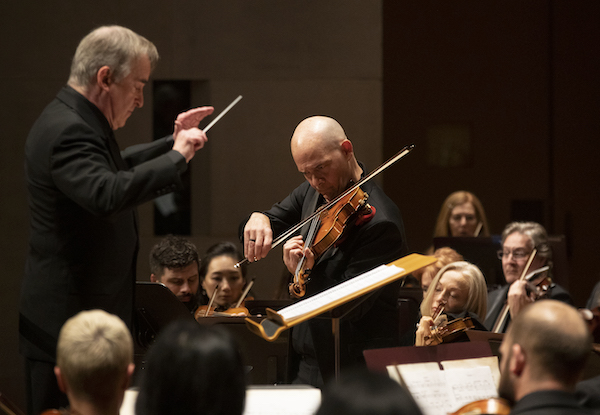Conlon, Dallas Symphony open year with gleaming Korngold, dark Shostakovich

In their first performance of 2023, the Dallas Symphony Orchestra presented a program themed on redemption Thursday night, with a trio of skillfully curated works by Shostakovich and Korngold. Despite the holiday hiatus, the concert drew a nearly packed house at the Meyerson Symphony Center with the DSO at its finest under guest conductor James Conlon.
The programed opened with Dmitri Shostakovich’s Festive Overture, a six-minute celebration of spirited frenzy and fanfare, which the DSO executed smartly.
Erich Wolfgang Korngold’s sole Violin Concerto followed to fill out the first half with DSO concertmaster Alexander Kerr as soloist. Hailed as the defining composer of Hollywood’s Golden Age, Korngold’s musical language is a distillation of his Viennese upbringing as well as reflecting the expansive melodies of his cinematic scoring.
Korngold’s concerto was dismissed by New York critics who deemed the work a “Hollywood Concerto” and “more corn than gold.” However, a 1953 recording of the work by Jascha Heifetz— who championed the work for decades—eventually brought the work into greater prominence with growing popularity and recordings by other celebrated violinists.
Conlon drew a clear sense of Romanticism from the orchestra, with consistently shimmering lines of lyricism running through the heart of the performance. Kerr led the opening of the piece with effusive phrasing of Korngold’ sumptuous themes. Korngold’s use of the celesta gives the score a special radiance, a quality captured beautifully by Conlon and the DSO in the second and third movements.
Bright horn fanfares injected the finale with vivacity, and Kerr demonstrated muscular virtuosity, leading the ensemble through dizzying rhythms before bold, quirkily strident coda.
Shostakovich’s relationship with the culture police of Stalin’s Soviet Union often saw him fearing for his life. His predilection for artistic exploration would draw the admonition of authorities, which, for many artists at the time, proved deadly.
Following the denunciation of his opera Lady Macbeth of the Mtsensk District in 1936 as “a leftist monstrosity,” the score of his Fifth Symphony would rescue him from Soviet disfavor and restore his former eminence.
Conlon is no stranger to the DSO or the literature of composers oppressed by the state. A champion of composers and lesser-known works that were silenced by the Nazi regime, his interpretation of the material was undeniably sensitive and intentional, to which the ensemble responded in kind.
The boldly jagged opening of the symphony’s first movement was affectionately dark, as cellos and basses led the strings in powerful octave sonorities. This was beautifully balanced against lyrical horns and shrilling woodwinds. The heavily frolicsome scherzo of the second movement was almost menacing as this balanced shifted to highlight passages of dark pizzicato strings and winds in brisk, buoyant brevity.
The slow movement—the emotional core of the work—was filled with intensity, actualized by Conlon’s deft control of expansive crescendos and the DSO’s polished execution. The finale, a thunderous rondo, brought evenly layered brass and crashing timpani for a rousing, theatrical finish.
The program will be repeated 7:30 p.m. Saturday and 3 p.m. Sunday. dallassymphony.org
Posted Jan 10, 2023 at 11:19 am by Greg Davis
Indeed this was a special concert. A bravura of a performance by the Dallas Symphony Orchestra. The enthusiastic response from the audience is a testament that we would like to see more of Conlon on the stage at the Morton H. Meyerson Symphony Center.